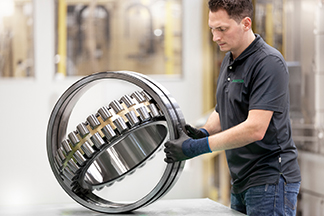


- Load distribution and contact stress
- Load capacity and service life
- Service life test methodology
- Friction
- Service life
- Application limits
- Rolling bearing dynamics
- Noise behaviour
- Rolling bearing damage
This practical training course will provide you with comprehensive insights into modern design methods and calculation tools for rolling bearings. You will acquire the knowledge necessary to ensure the long-term safety and efficiency of your products. Topics covered include reliable design, friction minimization, and noise reduction. The seminar combines theoretical principles with practical examples to help you apply the methods effectively. You will also learn how to correctly interpret calculation and simulation results, as well as how to select meaningful system boundaries for bearing simulation. This knowledge will help you better understand the interactions between rolling bearings and their installation environment. Additionally, you will gain insights into modern reliability forecasts in the context of Industry 4.0 that optimize economic operation and maintenance.
Load distribution and contact stress
Load capacity and service life
Service life test methodology
Friction
Application limits
Rolling bearing dynamics
Noise behaviour
Rolling bearing damage
Engineers
Rolling and Plain Bearings - Principles
Rotative Products @Schaeffler - Basic Training | FUNDAMENTALS
Ball Bearings - Basic Training | FUNDAMENTALS
Roller Bearings - Basic Training | FUNDAMENTALS
Special Bearings - Basic Training | FUNDAMENTALS
Rolling Bearing Know-How - Basic Live Training
Lubrication Technology - Basic Live Training
Rolling Bearing Failures Identifying Causes and Optimizing Operation - Basic Live Training
Mounting of Rolling Bearings - Basic Live Training
Rotative Products @Schaeffler - Advanced Training | EXPERT FUNCTIONS
Ball Bearings - Advanced Training | EXPERT FUNCTIONS
Roller Bearings - Advanced Training | EXPERT FUNCTIONS
Our training covers modern design methods and calculation tools for rolling bearings to optimize reliable design, friction minimization, and noise reduction.